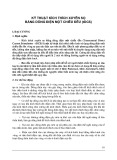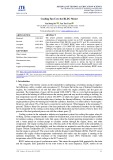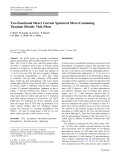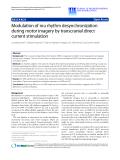
ISSN: 2615-9740
JOURNAL OF TECHNICAL EDUCATION SCIENCE
Ho Chi Minh City University of Technology and Education
Website: https://jte.edu.vn
Email: jte@hcmute.edu.vn
JTE, Volume 20, Issue 01, 02/2025
84
Cooling Fan Uses the BLDC Motor
Van Dung Do1* , Van The Tran2
1Ho Chi Minh City University of Technology and Education, Vietnam
2HCMC University of Technology (HUTECH), Vietnam
*Corresponding author. Email: dodzung@hcmute.edu.vn
ARTICLE INFO
ABSTRACT
Received:
23/08/2023
The article presents simulation results, experimental results, and
calculations of temperature control via an NTC temperature sensor and
then demonstrates Oled SH1106 using the I2C port for communication.
The author uses a 12V/100W BLDC motor with a maximum speed of
5380rpm to replace a 12V/100W DC motor with a maximum speed of
2200rpm. The author uses Arduino to control the speed of the cooling fan
and shows it through the OLED screen. The input of the control is an NTC-
type temperature sensor. However, this control method is independent of
the control on the vehicle's control box. This may be a limitation, but this
research mainly demonstrates the applicability of BLDC motors. Using the
overview method of DC motors compared to BLDC motors, calculate the
temperature to control BLDC motors to reduce the heat of internal
combustion engines and electric motors on cars. Replacing DC motors with
another motor is a step forward in the electric motor industry. BLDC motor
is an option to replace the DC motor.
Revised:
13/11/2023
Accepted:
04/09/2024
Published:
28/02/2025
KEYWORDS
Direct current;
Brushless direct current motor;
Electromotive force;
Oled;
Engine coolant temperature.
Doi: https://doi.org/10.54644/jte.2025.1456
Copyright © JTE. This is an open access article distributed under the terms and conditions of the Creative Commons Attribution-NonCommercial 4.0
International License which permits unrestricted use, distribution, and reproduction in any medium for non-commercial purpose, provided the original work is
properly cited.
1. Introduction
The design of the electric systems in the automobile is undergoing a revolution, aiming to improve
fuel efficiency, safety, comfort, and convenience [1]. We know that in the case of Internal Combustion
engines, the combustion of air and fuel takes place inside the engine cylinder, and hot gases are
generated. The temperature of gases will be around 2300-2500°C. This is a very high temperature and
may result in the burning of oil film between the moving parts and may result in seizing or welding. So,
this temperature must be reduced to about 150-200°C at which the engine will work most efficiently.
Too much cooling is also not desirable since it reduces the thermal efficiency. An internal combustion
engine produces power by burning fuel within the cylinders; therefore, it is often called a "heat engine."
However, only about 25% of the heat is converted to useful power. What happens to the remaining 75
percent? Thirty to thirty-five percent of the heat produced in the combustion chambers by the burning
fuel is dissipated by the cooling system along with the lubrication and fuel systems. Forty to forty- five
percent of the heat produced passes out with the exhaust gases [2].
Cooling systems in the automotive industry are important systems for cooling the engine when it's
working. System components include a radiator to dissipate heat, a fan or fans to ensure adequate airflow
for radiator cooling, a thermostat valve that opens when the desired operating temperature is reached
and a water pump (or coolant pump) to circulate coolant through the engine, hoses, and other
components. The engine cooling fan is one of the key parts of the electric system in the automobile, in
which high efficiency, high reliability, and low vibration are required to meet the above standards [3].
Engine Coolant Temperature (ECT) sensor measures the engine temperature and indicates how much
heat the engine is giving off. The sensor works with the Engine Control Module (ECM). The ECT sensor
monitors the engine coolant temperature continuously and makes sure the engine is running at the
optimum temperature. The resistance of the temperature sensor (NTC Thermistor) varies with
temperature when ECM sends voltage to the ECT sensor [4].
BLDC motors are a type of synchronous motor. This means the magnetic field generated by the stator
and the magnetic field generated by the rotor rotate at the same frequency. BLDC motors do not
























